Artist Interviews: Winners of The London Invitational 2023
17th Oct 2023
Galeria Moderna is a distinguished online art gallery which proudly spearheads a dynamic series of city-based national art competitions. A panel of esteemed judges, each a gallery owner or manager from the respective host city, selects twelve exemplary artists. These chosen artworks are then showcased in the 'Invitational Art Exhibition'.
Working in collaboration with Castle Fine Art, the UK’s premier commercial art retailer, and Cass Art, the aim is to offer unparalleled exposure to the winning artists. This is achieved through a blend of physical and digital exhibitions, complemented by concentrated media exposure and awards from esteemed patrons of the arts.
Below we catch up with the selected artists for the London Invitational 2023...
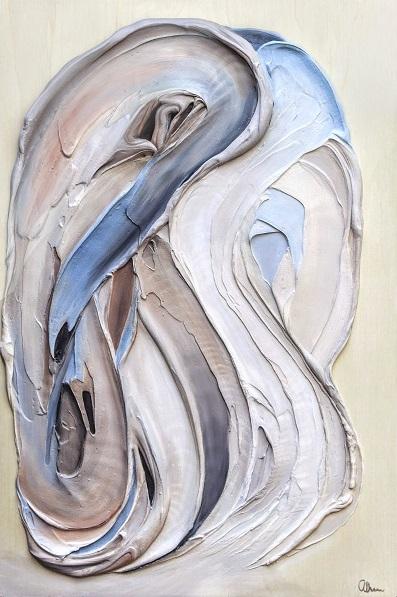
Cheryl Lee LeBlonde
Firstly, congratulations on winning the Cass Art Prize at the London Invitational! Your deeply textural work is wonderful, where did your journey into plaster art begin?
Thank you, I appreciate that. I started
exploring plaster around 15 years ago. I’d always been drawn to textural forms
of expression and my initial explorations had been with papier-mâchéand modelling
paste. They were interesting mediums but I wasn’t able to create the deep,
sculpted forms I had in mind. I experimented with non-traditional art
materials, like plaster and cement until I developed a mix that could be
adapted to the large deep planes of my textural abstracts to small sculptural
details of my figurative pieces. I’ve worked with the plaster mix ever since
and aside from its versatility what I love about using plaster as a medium is
the tactility of it. There’s a physical connection as you’re working and it
makes it so much easier for an emotional connection to follow, to infuse your
intention deep into the plaster itself.
We’d love to hear a bit about your first
piece.
‘Fatigue of the Soul’ is a special piece to me. Both artworks were created as I was recovering from a severe period of illness. A time when I couldn’t go anywhere, see anyone or do anything. For months I couldn’t do anything creatively, in many ways that was the most difficult thing for me. I had this unexpressed emotion building up, born from the situation I found myself in that had no outlet. As soon as I had recovered enough to hold a palette knife, I purged everything I’d been feeling into the plaster. This piece is an abstract of self and an expression of fatigue so profound it goes beyond physical, mental or emotional, it’s right to the very fibre of your being, your soul. I created the plasterwork instinctively in one sitting, and then built up the paint in thin acrylic glazes, reflecting the depth and complexity of what I felt.
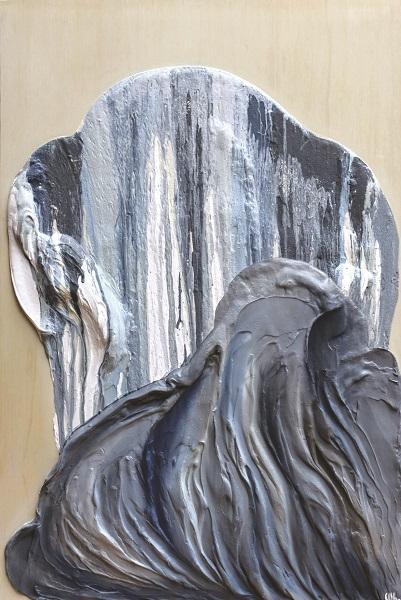
Your second piece uses a wave of cold colours. Can you expand on the importance of colour in this piece?
This piece, ‘Sublimate’ was really an expression of feeling so depressed, overwhelmed and lost, as though your true self is sinking and disappearing. You’re being replaced by the surge of negative thoughts and emotions that dominate this state. The colour palette needed to be cold because there is no warmth here. It’s a grey, frigid, lonely place that consumes your energy and motivation. There is always hope though, that just as it overtook you, it can recede and so throughout areas of the blue I added tones of warm burnt umber, as well as creamy tones of unbleached titanium and buff to the background. Sometimes you have to search for the warmth and positivity when you’re in amongst it, but it’s always there.
The titles you give your work are so poetic and insightfully connected to each piece. Tell us a bit about the process of writing the poetry accompanying your art.
Originally I had no intention of releasing these artworks. I made ten of them before I felt I’d fully expressed the highs and lows of my recovery. They were the most personal and intimate pieces I had ever created, having poured so much of myself into them and I didn’t want to talk about them let alone share them. Then I realised my experience wasn’t unique. People go through periods of depression, loneliness, frustration, hope, and often feel like they’re alone in it. Could sharing this collection help them feel connected, understood – seen? Once I made that decision, it gave the pieces new purpose, naming them and translating their meaning into the short poetic descriptions flowed really naturally. I would often just spend time reflecting on the pieces until the words that felt right came to me, and became the final aspect of the complete artworks.
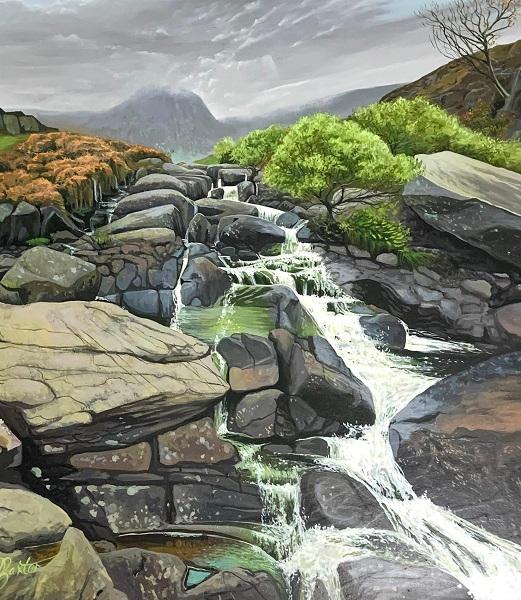
Debbie Baxter
Firstly, well done on receiving your award with the London Invitational 2023! We know you love painting trees, and we’re excited about your recent work painting water. Can you give us a bit of insight into this new direction?
I felt like somewhere around
2022 I needed new inspiration. Sometimes just a new environment can help and I
was given an invitation to stay in North Wales. The one thing that is massively
abundant here in the Snowdonia mountain range is water! Waterfalls, rivers,
lakes and of course the deluge that empties from the sky more often than not.
This immediately felt like the most important thing to connect with. I would
trek up the streams that came from the mountains, often stopping to watch the
colours and flow of the current. It astonished me the variety of colour that
could be observed. And every day so wildly different. As the sunlight hit
crystal clear water, it has a pale blue in the mountains with shimmers of green
and grey. Water I discovered is a beautiful mentor for painting. It takes me to
new depths with my art practice and a kind of magic happens like a meditation.
The forest and trees feel like the spirit of my painting journey and the water
feels like a call for my soul.
Your winning pieces are fantastic. Could you
tell us about your first?
‘Follow The Water To The Mountains’ is a waterfall very close to lake Ogwen. A bridge crosses this torrent and I could feel its full force coming straight at me. I was struck by the different paths the water took to get to its destination and the colours that the rocks and pools made as they shaped the very structure. Almost architectural and so wide. This natural place made over thousands and thousands of years. There is a special kind of energy to these falls a sense of coming from on high and cleansing the earth as it goes. The ions in the air, the purity of it and the velocity really does something to my spirit. I feel a kind of cleansing and freeing as I stand, study and absorb it. It touches my inner world as well as my senses and I can feel its energy deep within me. I can feel its force and intent, it is a thing of power and beauty.
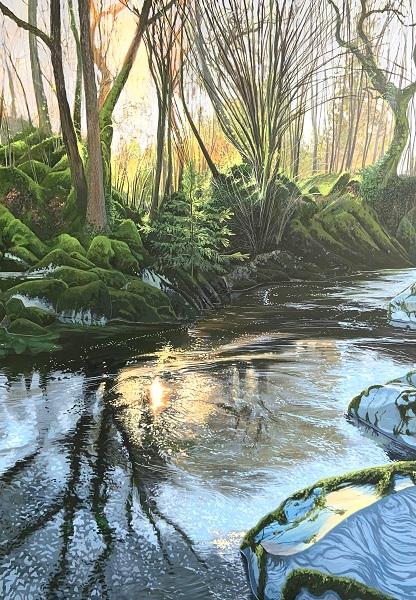
Can we hear about your second work?
‘Welsh Winter Flow’ comes
from a trek through the forest near Penmachno. An old disused Woollen Mill sits
alongside this magical river. Painted in February the first day of low winter
sunshine lighting up the distance through the trees. You can just see the
outline of an ancient Roman Bridge and I’m down by the water's edge looking
across to the other side. The rocks are amazing, so painterly and patterned by
the river's flow, a joy to behold. The river is full and almost brooding. A
feeling of currents within currents holding the icy coldness of the mountains. It's
a long slow swarming flow that only a winter river can show. I am mesmerised by
it, it has a special kind of voice. Different from the Waterfall it sounds like
a low hum and again I feel I’m held and transported by it. A place of healing
while a busy mind gets stilled and I am nurtured to relax into its powerful
flow. The reflections are spread different all over the river, not one single
part of its watery surface is the same. No pattern, I can see colours
everywhere but there is a kind of ancient harmony to it.
You capture beautiful moments in your
paintings. How much of your work is done on-site and in studio?
I trek often finding new places waiting for the sun to open up the colours and bring in the magic. I will walk for miles looking, gleaning and feeling. If I feel the magic of a place I will paint it. Revisiting often until I can get a sense of how to paint it. I may do ‘plein air’ just so I can have more time to take it in. I’m looking at the colours and the light and I'm feeling my way. It is not an experience of copying for me. I will bring this feeling back into the studio and start a painting by throwing colour at the wood panel. I’m not interested in form at this stage I'm only interested in expression and play. Then slowly I start to remember how I felt, what the environment was showing me and how I will reveal the magic that was there when I stood in front of it. From there I start to build form and composition and then I'm building in the light. It’s a very ergonomic process that feels like it is guided by nature itself. Most of the process then is done in the studio and becomes a kind of meditative experience. People who have my paintings on their walls tell me they have a sense of healing in their home. A place to dive into and be held for a while or perhaps reminded of our human connection to it. For me it's a constant journey of learning and the recognition that nature is the most powerful force on the planet, I feel I paint this lest we forget.
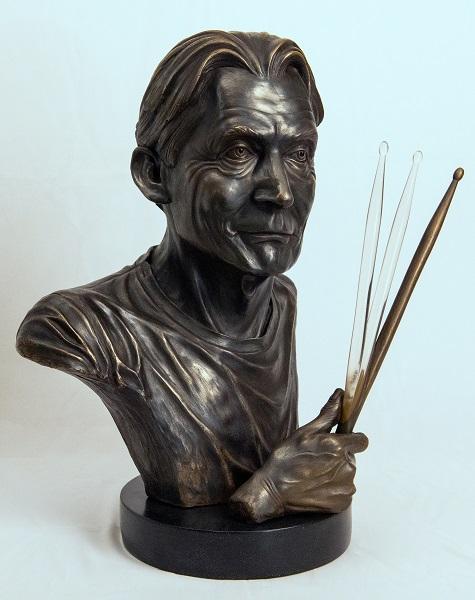
Dave Brown
Well done on receiving your London Invitational 2023 award. You’re well known for your political cartoons, working for the Independent for many years. How did you arrive at bronze and resin figurative sculpture?
I sculpted a little as a teenager, modelling small heads in plasticine, before teaching myself to mould and cast them in resin. At university I was disappointed to find my Fine Art course had no sculpture facilities, so by the time I graduated I considered myself primarily a painter. In 1980’s London finding affordable studio space for my large canvases proved a real problem, so I stumbled into cartooning from the necessity of practising a smaller artform compatible with bedsit life. I’ve been fortunate to have never been short of work as a cartoonist, but in recent years I decided to make more time for my own art. Initially, that meant painting again, but during lockdown, unable to get out and about, and bored with working from photos, I decided to return to sculpture. Now with each new piece I try to widen my understanding of the medium.
Tell us about your first winning piece.
As a drummer myself, this is my tribute to one of the all-time greats, Charlie Watts of The Rolling Stones. In all my portraits I aim to capture an aspect of the subject’s character, not only their likeness. Charlie’s playing anchored the Stones; his style was undemonstrative, his economy of movement contrasting with their animated performance. He seemed to play with a wry smile on his lips - as if amused by their antics - and I attempted to capture that look, along with the quiet, purposeful stillness of his head, while also introducing a sense of the dynamic motion of hand and stick. Whilst the bulk of the work is cast in a darkly patinated resin/bronze mix, I have contrasted that with a clear resin for the ‘ghost’ sticks in an attempt to bring that sense of progressive movement to what is, intrinsically, a rigid medium.
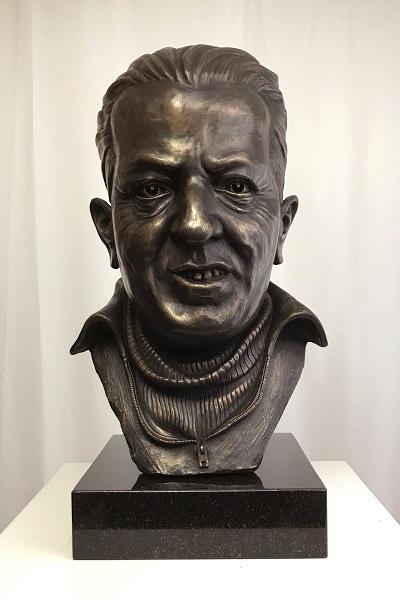
Could we hear about your second winning piece?
This is Jimmy Murphy, an important figure in Manchester United history; his coaching developed the young players who became known as the ‘Busby Babes’, he took charge of the team after the Munich air tragedy, and also led the Welsh national side to the World Cup quarter finals. Initially a quick head study in clay, made toward a potential commission, I later decided to create a more finished piece from it, enlarging it into a full portrait bust and moulding and casting it in resin/bronze. My impression of Jimmy was that, whilst a hugely sympathetic character, he was also an incredibly determined ‘no nonsense’ man, largely unconcerned by appearances. So here I enjoyed the way the addition of the slouchy old roll neck mirrored the folds and creases of his face, while the broken zip of the training top echoed the characteristic uneven teeth beneath his warm smile.
You capture characters with very different styles. How do you develop them for each portrait?
In portraiture, working directly from life is generally preferable. However, one drawback can be that, sitting for some time, the model adopts a neutral expression, possibly resulting in a bland sculpture. With my two winning pieces I necessarily worked from historic photographs, but that does give an opportunity to research typical facial expressions. This, in turn, can lead to a greater appreciation of the subject’s character rather than capturing a face in repose.
I work initially in clay, building up the head over an armature, and checking it against reference photos and my own drawings. A silicone mould is made from the finished clay before the work is cast in bronze or resin/bronze and finally patinated. Whilst a simple portrait head can make a powerful statement, the careful inclusion and treatment of other elements of the body, or aspects of clothing, can add a lot to the development of character.
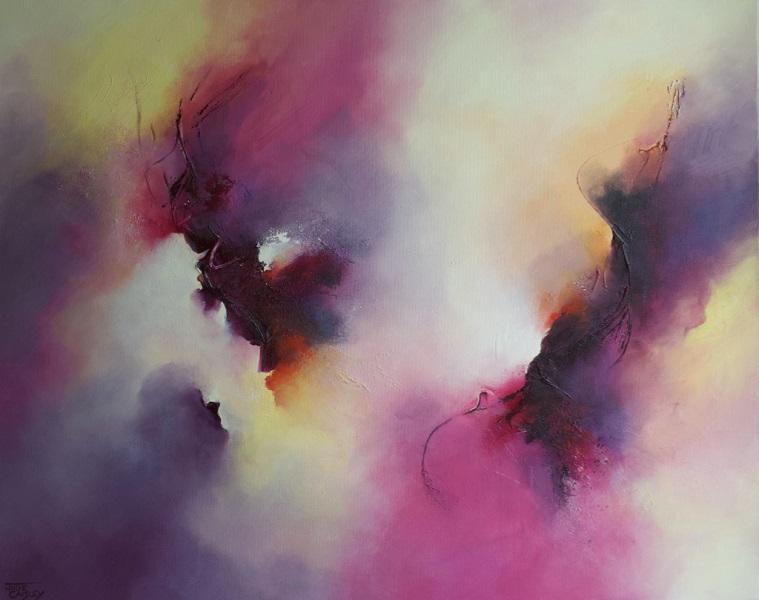
Jude Caisley
Congratulations Jude for winning in the London Invitational 2023. What inspired you to start colourful abstract paintings and who were you influenced by?
Thank you, it has been such an honor to receive this award! I think I have always been drawn to colour, and when I began to paint, I thought ‘let's start by exploring colour in more depth’. However, 11 years later I have still not got to the bottom of it. I remember going to see the Paul Jenkins exhibition at the Redfern Gallery in London in 2016 and being amazed by the beautiful canvases filled with areas of pure colour. This was such a delight to me and a major influence on my work. Jonas Gerard and David Kessler have also been great inspirations to me, not only for their finished work, but also their expressive creative process.
Can you tell us about your first winning piece?
'Sweet Surrender’ is predominantly about light and dark, calm and storm. Areas of stillness combine with areas of intense activity, a paradox of the human condition. However, in the realisation and act of surrender to our own frailty and smallness, there comes a sweetness and a peace. Luxurious and deep shades of magenta, purple and orange combine with soft yellow and pink tones. Areas of raised texture, high contrast and sharp edges contrast with lighter, softer and smooth blended sections. It is painted spontaneously and intuitively in acrylic on a deep-edge canvas.
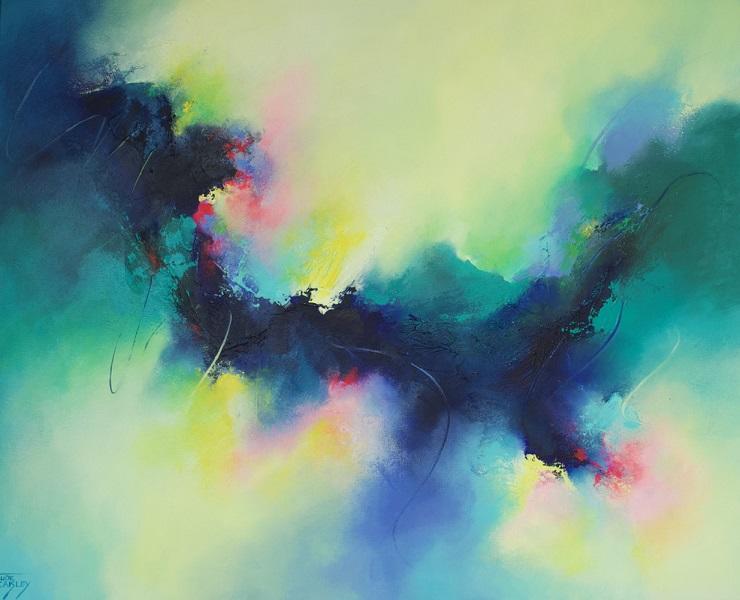
You talk about your work reflecting and releasing what’s inside. How does that apply to your second piece?
This image is called 'In the Garden’. It is a bold painting bursting with movement, rhythm and energy. The river of life flows and dances through the centre of the canvas bringing nourishment, vitality and refreshment to everything it touches. This piece is created with rich tones of blue, turquoise and green with fluorescent pink splashes that hover over a soft yellow light. I do believe that when we create something new, especially in abstraction, we always release something of our unique personality, experience and beliefs onto the canvas. In this case, we too can have a river flowing in and through us that gives life.
Your
work has so much colour and movement. What materials do you use to achieve
this? Do you have any recommendations?
I work in acrylic paint and use the heavy body acrylic by Golden. It is in my opinion the best acrylic paint due to the high pigment content and also you can buy it in large pots, so any leftover paint can be replaced and not wasted. It is expensive but beautiful to work with because of its thick, creamy texture. I sometimes mix it with cheaper brands, for instance Winsor & Newton Galeria paint when creating different tones and new colours. Also the Winsor & Newton deep edge canvases are my favourite at the moment, because I feel they have more substance and a better finish than many of the cheaper brands.
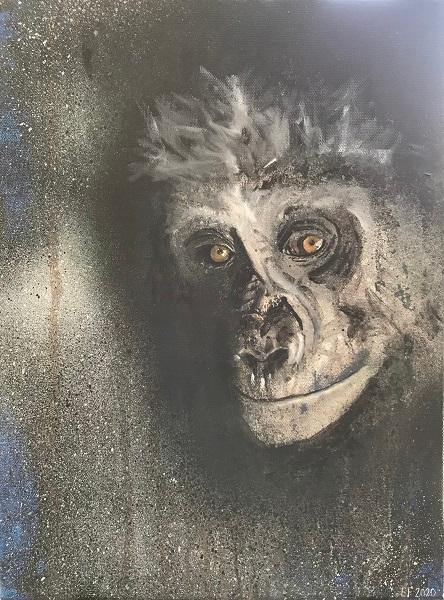
Ella Feld
We love your painting series on endangered species, and well done for winning in the London Invitational 2023. When did you start painting animals?
Thank you so much, it's such a huge honour to be one of the 12 winners, I am still suffering with imposter syndrome! I am truly grateful to all involved. I initially started painting animals (dogs) in 2017 as part of a diploma in Art and Design whilst I awaited and healed from abdominal wall reconstructive surgery. I've always been passionate about animals, and their rights, and decided to make my final pieces for the course based on dogs. The first piece was based on a poem written by Niki Benney called ‘Poem for The Lost’, a poem about The UK law that illegalises Pitbulls. I made 7 pages of illustrations to go alongside the poem. My second final piece was a children's book I made using drypoint etching technique, based on one of my rescue dogs, ‘Introducing Samuel and a bit about dogs’, illustrating and describing basic facts and needs.
Can you tell us about your first piece?
During the beginning of lockdown, I was living in a van parked outside a small art studio space I was hiring. I needed something to get my teeth into, something that felt I was helping in some way. Due to a life changing injury that occurred in 2015, I was unable to continue my life's passion as a veterinary nurse in Animal Rescue Centres and lockdown made me feel useless. My first piece for the Endangered species project was a close-up of an orangutan, I used an old canvas that I made an abstract background from acrylic paint and then painted the Orangutan with oil Paint, his eyes glaring and staring at the viewer, as if trying to jump out of the canvas and escape the chaos in his distant surroundings as humankind destroys his habitat.
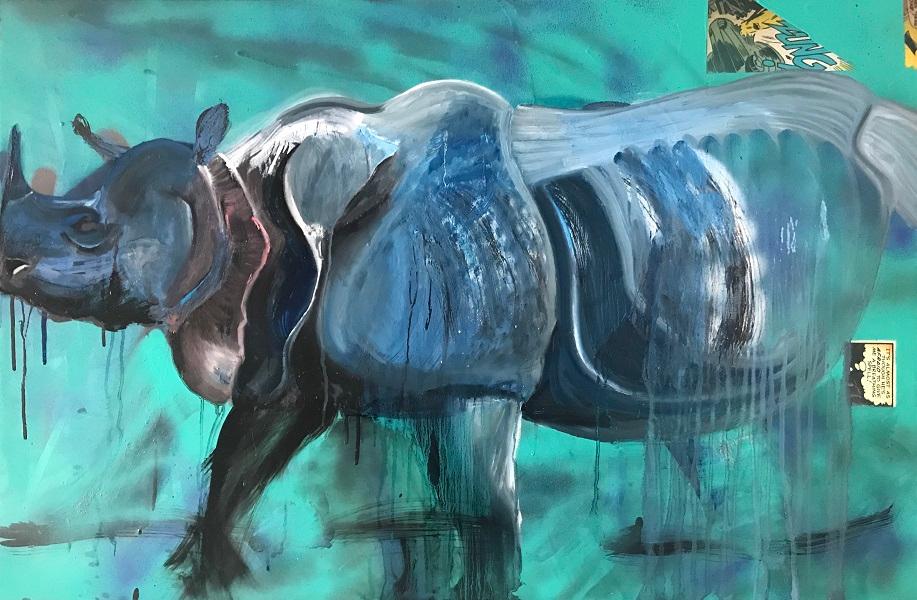
Can you tell us about your other works?
I had lots of
fun making my second piece for the Endangered series, oil paint on canvas of 4
beautiful Lemurs all huddled together,trying to capture their genuine
cheekiness and innocence but my second piece soon turned into my third and
fourth and so on, until i had oil and acrylic paint everywhere and a studio
full of Endangered species, including elephants, wild dogs, bears, tigers,
Gorillas, Rhinos and many Orangutans!
What art materials would
we find in your studio? Do you have any recommendations?
My studio is my front room, in it you will walk into organised chaos! Paints everywhere, pens, charcoal, inks, spray paints, brushes, a broken easel and an old-fashioned school desk plus lots and lots of canvases and frames. Due to my disability that stops me from doing everyday tasks such as shopping, most of my equipment comes from online shopping. I highly recommend Cass Art for all sorts of materials and equipment, ranging from pens to brushes to paper and paints and many more inspiring tools.
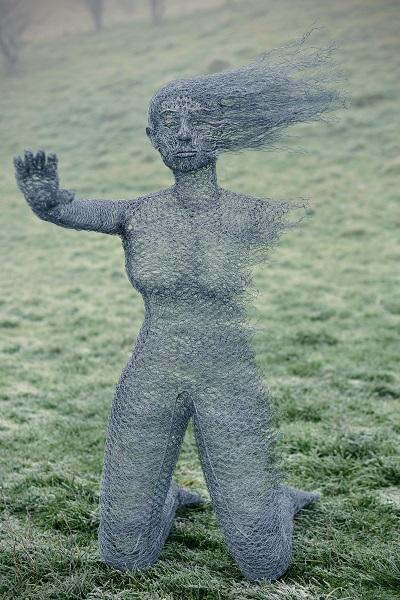
Richard Gibson
Congratulations for being a London Invitational winner with your open wire sculptures. When did you start using this medium and what was your inspiration?
My
previous job was in ecology and one day I was surveying a pond for newts and I
saw a basic duck sculpture the client had made out of some leftover wire. I was
more interested in the way the light interacted with the sculpture than the
actual sculpture itself. I was practicing taxidermy at the time, so I was quite
familiar with natural forms and I started to experiment with wire. I soon fell
in love with open wire sculptures as it fascinated me the way the light reacts
with the medium. A sculpture can look totally different from one day to the
next and I’ve been fixated with open wire sculpture ever since. It doesn’t have
heaviness of some of the other sculpture mediums, which I think lends itself
particularly well to portraying energy and movement.
Your award-winning
pieces are more abstract than previous work on animal sculpture. Can you tell
us the thought process behind your first piece?
My first piece ‘Fading Away’ was a chance for me to do something totally different. I wanted to create a sculpture that was really thought provoking that would draw people in to give their own interpretation. The piece itself broadly focuses on the desperation of the human condition with particular emphasis on women’s mental health. I feel the pressure to fit certain moulds in such a fast paced instant gratification society is often overwhelming and sadly leaves many behind. I felt that the wire unravelling into the wind all along one side of the sculpture would really exploit these ideas. I wanted the face to look silent with the single hand out to depict a quiet cry for help, it’s almost like the piece is not wanting to make a scene whilst it actually does the complete opposite.
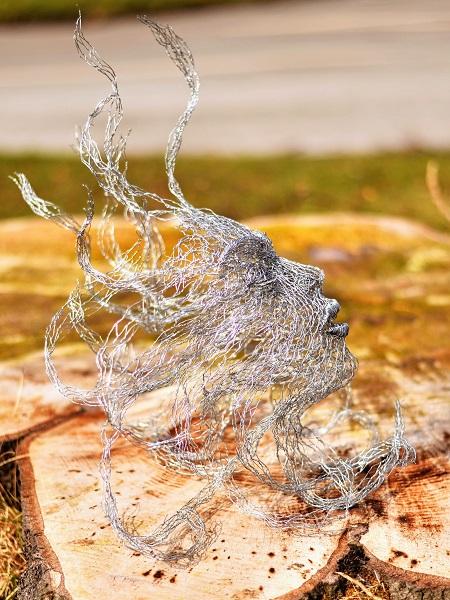
Could you tell us about your second winning piece?
I’ve always been interested in flow and movement and I think that shows in my wildlife sculptures. I wanted to capture a snapshot in time that represents embracing the present moment whist also depicting the flow of life. ‘A Moment of Bliss’ was my interpretation of the sense of bliss when you are simply lost in the moment. It’s a contrast between the fleetingness of existence and heightened states of flow and pleasure. I felt that the central face which swirls and fades in all directions would be a really effective way of interpreting this and I love the way it turned out.
Your
entries are amazing and we love that they’re different to your usual style.
After winning this significant award, is this abstract style something we’re
going to see more of?
I’ll always have a soft spot for capturing animals and in particular the movement of animals but I always enjoy exploring new ideas. I’ll definitely continue experimenting with more abstract work. Consciousness has always fascinated me as has the human condition and I look forward to exploring these ideas further.
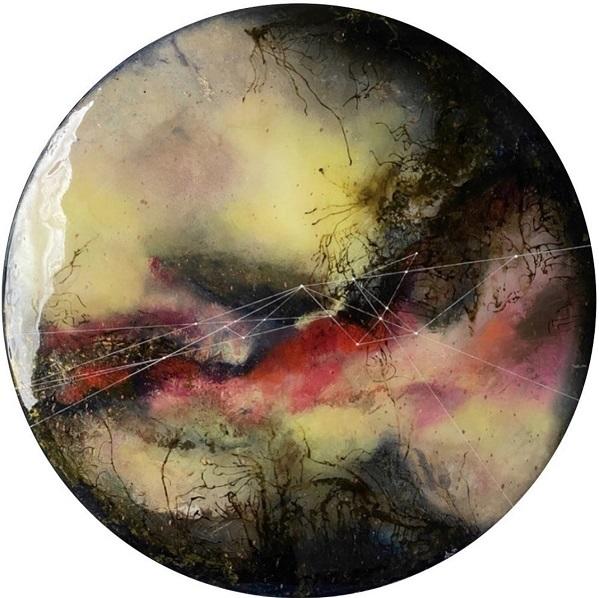
Annabelle Losa
Hi Annabelle, congratulations on being one of the twelve winning London Invitational 2023 artists. Can you tell us where your passion for painting came from?
My earliest memory I must have been 4 or 5 years old crayoning on the living room walls, it didn’t go down well! I would sit colouring and doodling all the time! I used to love sorting the pencils and felt tips into their colours and types I remember feeling very peaceful. I was 7 years of age when I won my first art competition and was featured in the local newspaper. I remember the photo very clearly; I was sat on the sofa presented with a wooden box of mixed art materials. Years later seeing the photo, I thought what fantastic lino prints the hideous flock wallpaper would have made! I also remember a eureka moment that making my lines thicker on drawings enabled me to NOT colour over the edges. I was so pleased and thought I had discovered the world’s first.
Your emphasis on the viewer’s experience of exploration and imagination in your art really comes across. How did you go about creating this experience in your first winning piece?
Valuing the viewer’s experience of exploration and imagination in my art is essential it has the power to transform provoke and impact on many levels. Ultimately, I am inviting the viewer to embark on a journey with me. I pour my heart into every piece I hide text, poetry and song lyrics, layer upon layer upon layer. This enables my work to hold a precious intimacy that you can enjoy that is unique to every individual. My paintings often develop into landscapes, abstract and impressionistic. Abstract in my mind implies that the viewer is not going to understand the work and see it in the same way as the next person. What I find most exciting is that people who love my artwork bring their own story and unique engagement to the work.
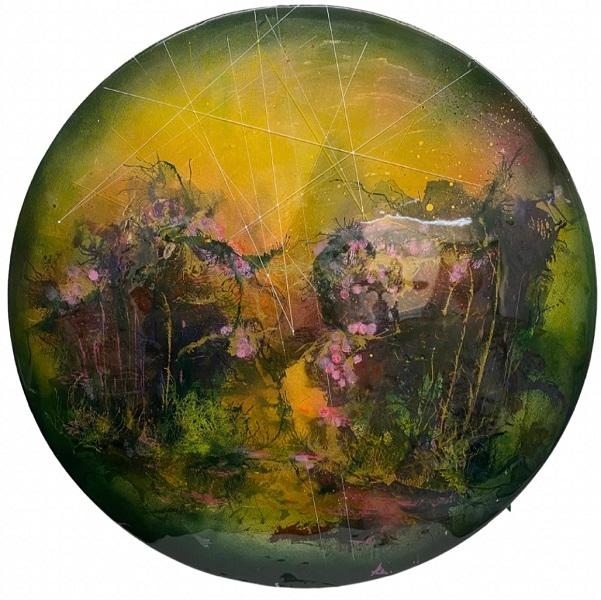
Could you tell us about your second piece?
Both pieces of work carry the essence of escaping to another worldly place or space. With ‘Captivate’ I wanted to create the thought of a dwelling place a secret place of solitude and beauty. Through a careful selection of colour palette, mixed media and form this piece is quietly expressive with an emotional response to memories of secluded peaceful moments. Emotion, memory and environment are key in what I paint. I use a lot of mixed media and stray away from using usual painting tools such as paint brushes etc. I tend to use a lot of kitchen tools and other devices to create my marks even my fingers become into play. Layers, veils ultimately create the depth and light I require.
When did you adopt the multi-layering process of resin and paint, and who were you influenced by?
The layers and depth I create within my work come from my background in printmaking when I studied Graphic Fine Art at University. I favoured screen printing, the way transparencies with pigment could be layered to give multiple depths. My love of 17th century landscape painting is also key with their multilayering techniques and layers of varnish that reveal secrets to the works if you were to start to remove the layers. I adopted the use of resin probably around five years ago when I wanted to explore a glass-like finish but with painted layers in between. Resin, even to this day, I feel I have not mastered as it is quite scientific in the measuring of resin and catalyst. The precision of the mixing and temperature are important, each piece I make must be made in a clean space and because of the curing time, the works can take up to three months at time.
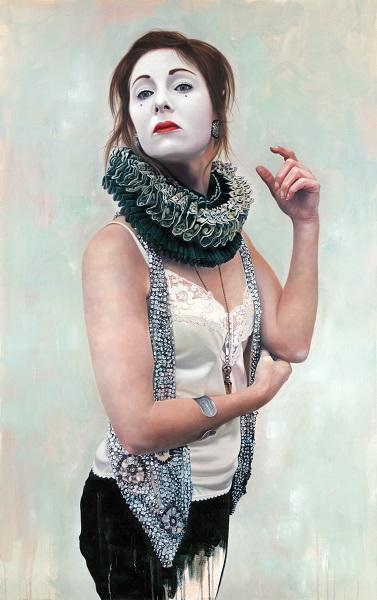
Solly Solomon
Congratulations Solly, your London
Invitational 2023 award was very well deserved. When and how did your passion
for painting begin?
I grew up from the age of six having watercolour lessons with my Gran who was a floral artist. Looking back, I think both working in watercolours and painting flowers are two of the most challenging aspects of painting and so it was a good grounding in that respect. She brought me up from the age of eight and so I would walk into her room every day and watch her paint or draw, I think a lot of it I absorbed just through the act of observing her and listening to her talk through her processes and colour mixing. You can learn a lot like that – how to think like an artist.
We’d love to hear about your
first winning piece.
‘You Have No Idea of the Gift You Once Gave Me’ is the first in my ‘Conversations in Therapy’ series and is an expression of gratitude to my two friends who encouraged me to go into therapy when I was seventeen. I didn’t want to go but it turned out to be one of the most important (and painful) relationships of my life. I sometimes wonder how my life might have worked out differently had this not happened. 14 years later I re-connected with this same therapist and embarked on another journey with her. The paintings in this series were in part visually inspired by Peter Greenaway’s Propero’s Books and although I am not the model, the paintings became a series of self-portraits, if not in the literal sense. They are paintings about myself, about my life.
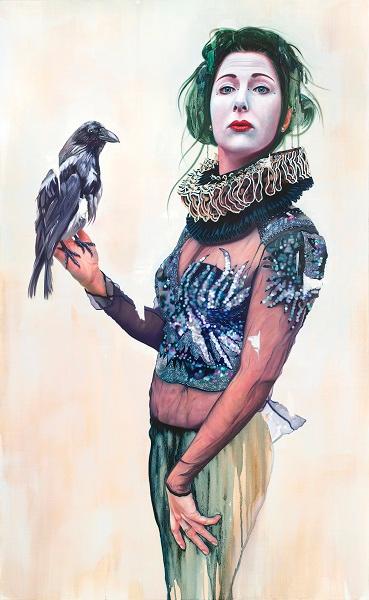
Could you tell us about your second piece?
‘I Think You Will Always Be With Me’ was created when I was attempting to
process the ending of my therapy. I was inspired by a Tracy Emin documentary in
which she spoke of researching many cultures around the world that have a
reoccurring belief that birds carry the souls of the dead onto the next life. I
was really taken by this idea and used the raven to represent grief in this
painting. It is a reminder that the ones we hold dear to us become
a part of who we are and in that way, we carry them within us forever. ‘I have
been woven into you, like you have been woven into me.’
You explore themes of
self and identity with fantastic imagery and colour. What inspires this
imagery?
My background in theatre has definitely been inspiring in an aesthetic sense. In a way, it’s been a kind of organic process because my work has always been very autobiographical in nature. For example, I literally used to wear white make-up in an attempt to hide the colour of my cheeks (which was to be one of very many make-up mistakes I have unfortunately made over the years). This masking felt like it was intrinsically linked to theatre and the idea of the sad clown, of Pierrot, of the idea of hiding your emotions from others, of putting on a happy performance whilst at the same time literally hiding yourself. I see the ruff as an extension of this costume, of this mask.
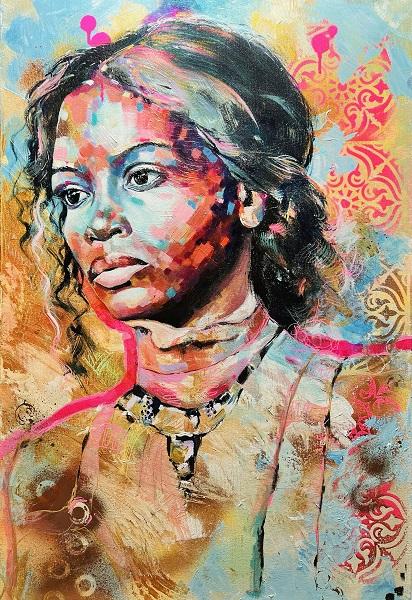
Kirsten Todd
Congratulations on winning at the London Invitational 2023 with your vibrant portraits. We love how you use colour; could you expand on the importance of that for you as an artist?
The role of colour in my work is vital, it is integral to the meaning and impact of each piece. Colour is a language unto itself, one that speaks to our emotions and subconscious minds. It has the power to evoke specific feelings in viewers, even before they consciously recognise what it is that's causing those feelings. In my work, I use colour as an avenue for expression, to convey emotion, energy and mood through the application of different hues and shades on canvas. The emotive energy of colour is at the heart of my artwork; it gives me a way to express complex feelings without having to rely on words or narrative. As I create my pieces intuitively, I feel my way through the piece and the colour ends up not only with what the piece is showing but also what it’s telling. Colour adds depth to my work; it adds layers and nuances that help me tell stories that are more than just what you see on the surface.
What inspired your first winning entry?
Both my pieces are paintings from a collection entitled ‘The Divine Feminine’ which seeks to empower women, give them a voice, seeing their inner strength and beauty. It speaks of our interconnectedness to all that exists and each other. The divine feminine is the force of creation and destruction, and it's everywhere, from the smallest molecule to the largest star. It's in our bodies, in our minds, and in our communities. The divine feminine gives us a voice - it empowers us to speak up for ourselves, for each other, and for what we believe in. It gives us the strength we need to stand up for ourselves when someone else tries to take away our power or tell us what we should do with our lives. It allows us to be vulnerable enough to love another person fully and unconditionally - and yet still be strong enough to stand up for yourself when necessary.
The energy in my painting is expressed through the strength of the woman in the foreground. She is free from ancestral karma, she has overcome her past imprints, and she is ready to move forward into a new chapter of her life. Women have been oppressed for thousands of years, and there are still many people who believe that women should be subservient to men. But today we're seeing a shift in consciousness - more women are beginning to feel empowered by their inner strength and their connection to all that exists. This beautiful woman inspired me to share this message and is asking us to let go of ancestral karma and patterns handed down through the generations; to free yourself from ancestral imprints so that you can live your life fully without being weighed down by the mistakes of others who came before you. She feels the sense of freedom from past limitations. She is free from self-criticism and judgement and the burden of past influences in her energetic field.
We can use our negative experiences and mistakes as a way to become stronger. We are not our past mistakes, we are not our patterns or imprints handed down the ancestral line, we are all powerful beings who have the ability to transcend our past experiences, and we can use them as a way to grow into greater power, creating our own new realities.
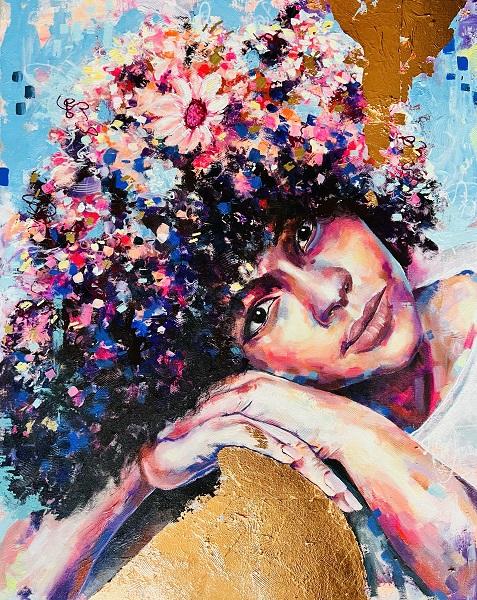
Could you tell us about the feminine energy you capture in your second piece?
This
piece highlights the rise of the Feminine energy in this time of great change
as we, our planet and our universe are on our journey of ascension to a new
vibration. Celebrating strong women from all cultures, capturing within them
inner strength, but also capturing a moment to see their vulnerabilities, their
softer side and their feminine essence. Highlighting the struggle of women to
be accepted as equals, giving women a voice, seeing beauty within and
celebrating cultural diversity. The work speaks of empowering women, after
centuries of suppression of the powerful female energy. Women are the creators
of humanity, and that creative force is one of the greatest powers there is. It
is now time for women to reclaim their innate strength and wisdom, be heard and
accepted as equals and the Goddess energy they possess within allowed to shine
forth. The Divine feminine energy should be revered and respected. Women are nurturing, compassionate and wise
by their very nature. I want to celebrate the strength and wisdom women hold
within, and our connection to each other and all that exists.
You use a great variety of materials. Can you
talk us through them?
I mainly use acrylic based paints, starting off each piece with an abstract background, I tend to use acrylic paint and bold strokes of spray paint to add swathes of colour. In creating the background oil pastels and acrylic ink can be added in areas as well as acrylic paint pens. Then when building up the portrait, I usually use acrylic paint with acrylic paint pens to add details and highlight, along with oil pastels, then finishing touches such as copper or gold leaf, spray paint etc might be added to certain areas, all of which creates the effect of merging and melding the portrait with the background creating that connection and symbiosis to each other - symbolic of our connection to everything and all matter, of our plane of duality of being two independent and individual parts yet connected and remaining part of the whole.
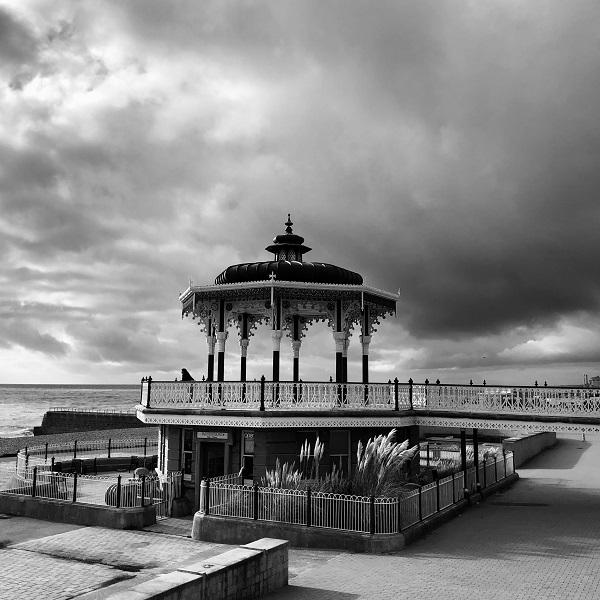
Eva Turrell
Congratulations Eva on receiving your London Invitational 2023 award. What started your interest in photography?
Thank you, I am very honoured. I always liked photography, the alchemy of it, but had little opportunity in my younger years. When I moved to London there was so much to see, and I started to take my own photographs in 1987 through the day access programme at Central St Martin’s under the watchful eye of my tutor Geoffrey Ireland, who ran the photography department. I had a simple Pentax camera and black and white film and learned through practice and Geoffrey’s guidance. I love black and white photography, especially portraiture.
You talk about capturing how places present themselves to you. Could you tell us about your first winning piece and its location?
I believe that how places present themselves to me depends on the state of my own mind. I was in Brighton at the end of October 2021. It was a cold, windy, cloudy day - I was alone and probably felt a bit lonely. My attention was drawn to a lone person standing in the famous Brighton beach bandstand and I took a photo. That picture was the first image, in a series of five in total, and is the picture asked about here.
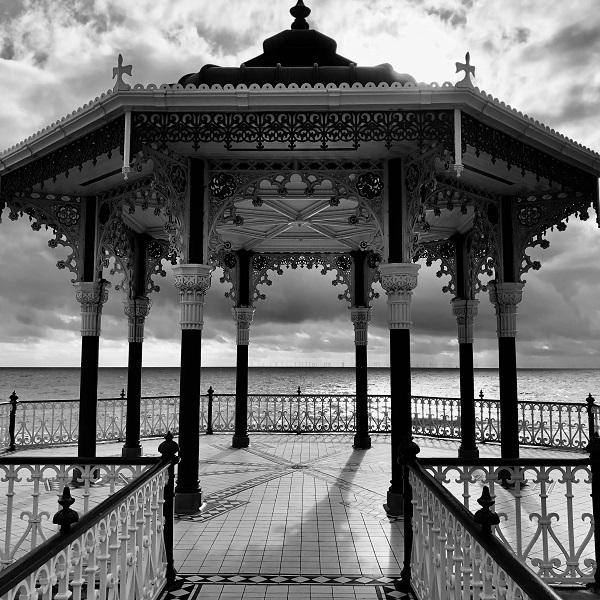
Tell us about your second piece.
After taking the first image I made my way to the bandstand as fast as possible but the person was gone and I was alone looking at this magnificent example of beach architecture. It was me and it. I didn't think much, I just took another photo. I love the symmetry and elaborate design, the frills and straight lines against the moody sea and sky, all luminous on that day. This is the second image in the series.
You take great photographs, both in black and white and in colour. What do the different forms mean to you and how do you choose which to use?
For me, black and white is all about playing with light and shadow and greyscale. Colour photography is more, in my view and the way I use it, immediate, representative of the moment and place and me in it. As you can see the results immediately in a digital camera or a smartphone, I often follow my intuition or play with the image to see what works, which form is better to represent my idea. New technology has made it so easy to adjust photos on the go that it becomes another way to focus the meaning of an image, or reflect the mood. Having more tools doesn't mean making better images, but it can be liberating to have options. I took these images on a smartphone in colour and converted them before printing as it was clear that black and white would be much more responsive to available light, reflecting the conditions of that day - and the person taking them.
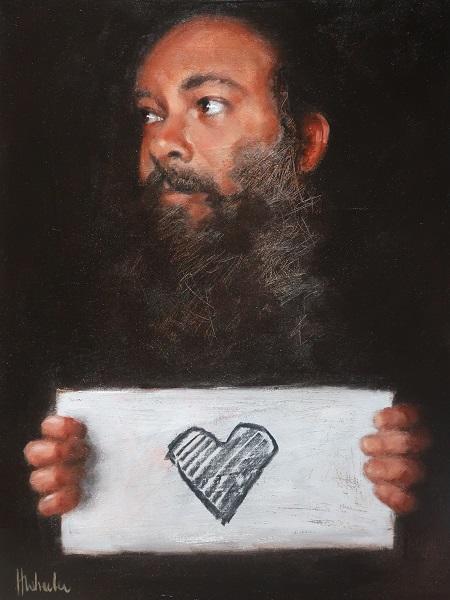
Hannah Wheeler
Firstly Hannah, well done for your London Invitational 2023 award. We love your use of chiaroscuro lighting in your portraits, contrasting light faces with dark backgrounds. What inspires you to use this technique?
Thank you, it
was a pleasure being involved. My off-grid upbringing has been the biggest
influence with this dark style. I love immersing myself in history, so
connecting my own experience of an old fashioned childhood by candlelight with
the beautiful masterpieces of Caravaggio and Gentileschi gave me confidence and
comfort to explore a colour palette and intensity I was naturally comfortable
with.
Can you tell us about your first winning piece?
As my paintings are often expressions that people may read in different ways depending on their own frame of mind, I like to keep a level of ambiguity. The first painting ‘The Cruel and Curious Heart’ was inspired by an old western ‘wanted’ poster. The subject is offering up a heart but possibly showing self preservation in the glance away.
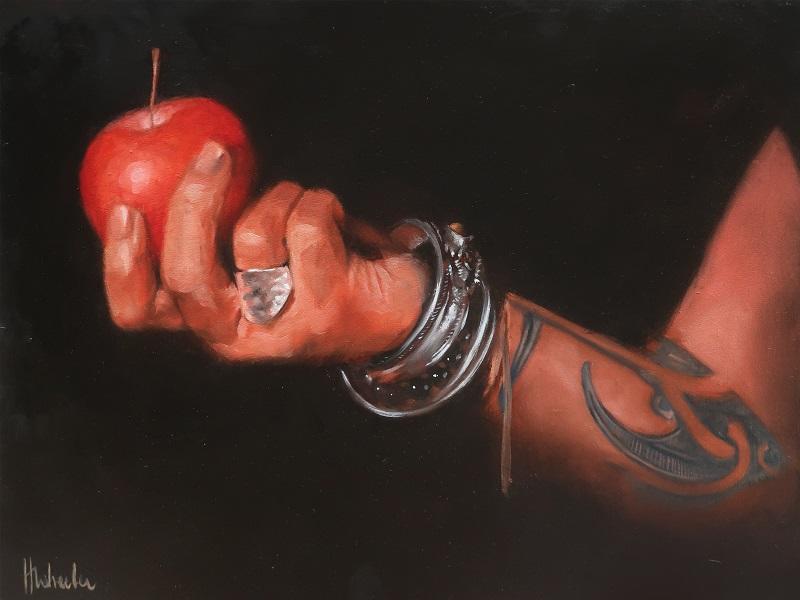
Tell us about your second piece.
‘An Offer You Can’t
Refuse’ was part of a series studying tattoos, this one featuring a Maori
design. The apple symbolises growth, strength and peace but The Godfather
reference as the title presents a darker intent. Again, it’s open for
interpretation.
You also work with the Ethical Health programme supporting people through
mental health crises with your portraiture. Can you tell us a bit more about
that work?
The Ethical Health Consultations take place in Zurich. I spend time with the client, sitting in on some of the therapy to build a connection between myself and the client, which will strongly influence the painting I will produce from it. I take a small set of photos and return to my studio in Cornwall to do the work. The resulting painting gets used as a tool in the ongoing therapy, giving the client an anchor point in their process. The work is confidential as part of private therapy so it will never appear on my website, but it’s an absolute privilege to be part of a recovery program.
Thanks everyone!
Feeling inspired?
For further insights into the artists and upcoming competitions, explore the Galeria Moderna website Hub at galeria-moderna.com



